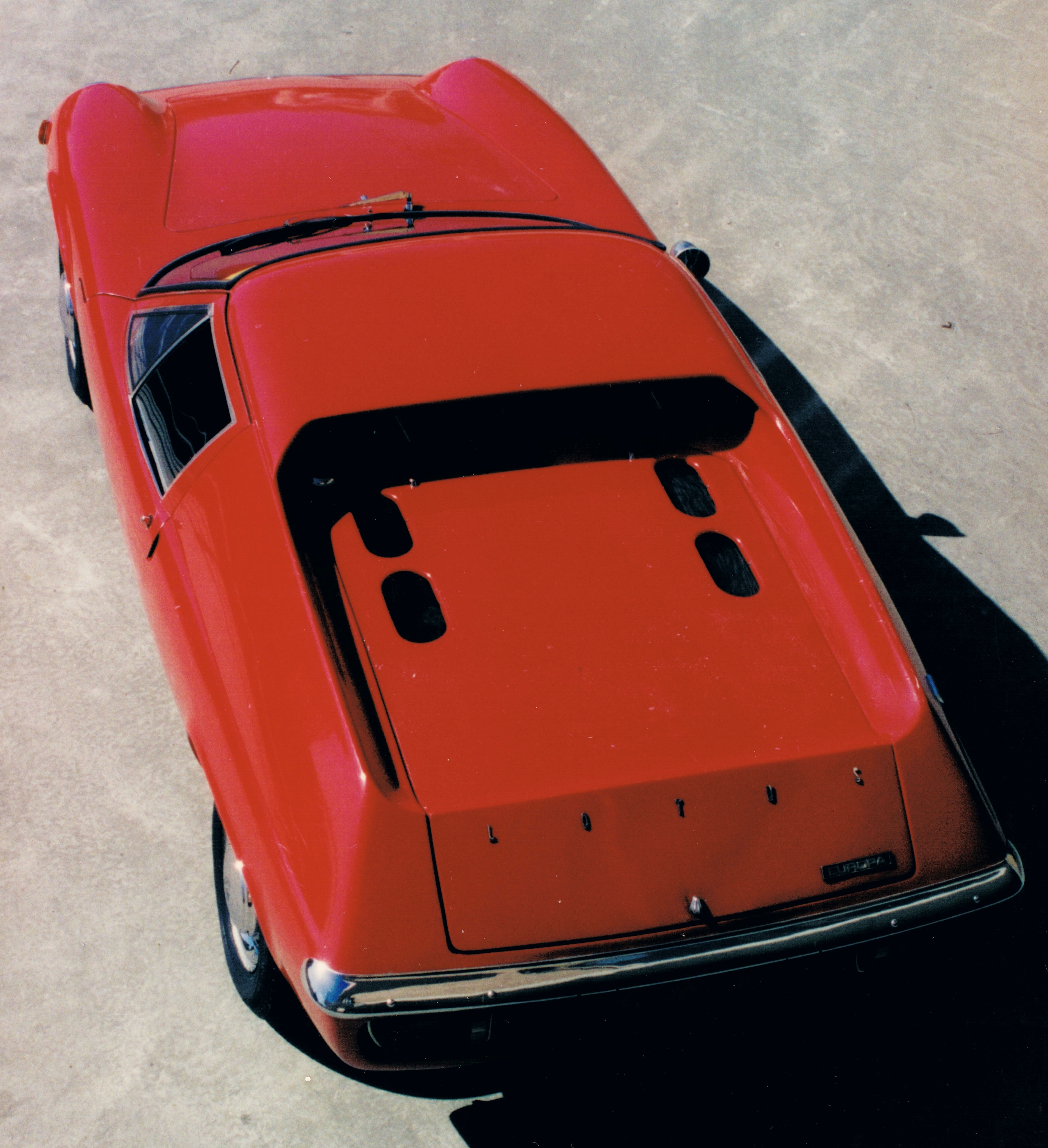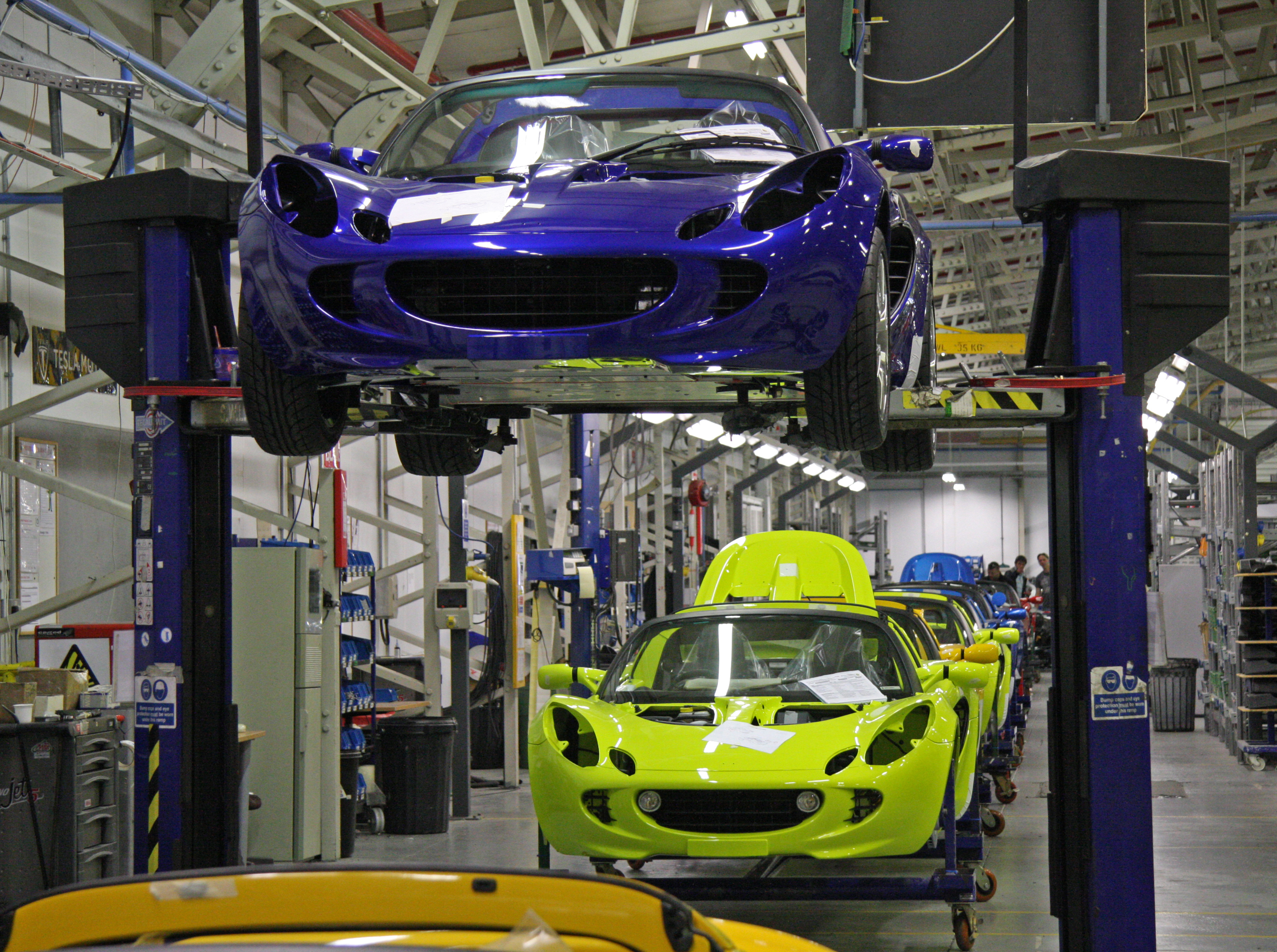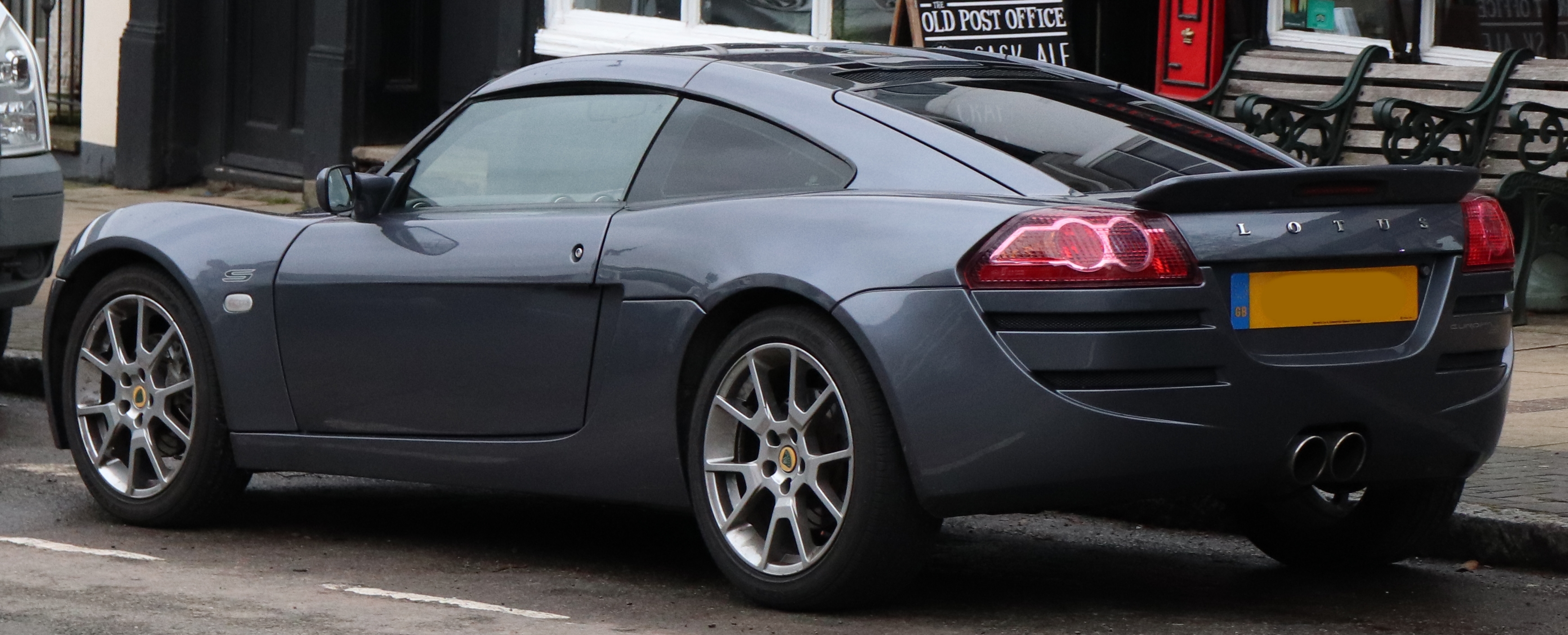|
Lotus Europa
The Lotus Europa name is used on two distinct mid-engine GT cars built by British automobile manufacturer Lotus Cars. The original Europa and its variants comprise the Lotus Types 46, 47, 54, 65 and 74, and were produced between 1966 and 1975. The name was later revived in the Type 121 Europa S, a sports car based on the Lotus Elise produced from 2006 to 2010. Europa (1966–1975) By the mid-1960s, the mid-engine vehicle configuration was well-established as the optimal design for Grand Prix cars, however almost no road vehicles yet used this arrangement. Lotus planned the Europa to be a volume-produced, two-seater mid-engine sports coupe built to reasonable cost, quite an ambitious goal for the time. Like all Lotus vehicles of the era, the Europa was designed and built following Colin Chapman's oft-stated philosophy of automotive design: "Simplify, then add lightness". To this end, a number of ingenious design approaches were made by Lotus to allow it to economically overcom ... [...More Info...] [...Related Items...] OR: [Wikipedia] [Google] [Baidu] |
Lotus Cars
Lotus Cars Limited is a British automotive company headquartered in Norfolk, England which manufactures sports cars and racing cars noted for their light weight and fine handling characteristics. Lotus was previously involved in Formula One racing, via Team Lotus, winning the Formula One World Championship seven times. Lotus Cars was founded and owned for many years by Colin Chapman. After his death and a period of financial instability, it was bought by General Motors, then Romano Artioli and DRB-HICOM through its subsidiary Proton. It is currently majority owned by Chinese multinational Geely, with Etika Automotive as a minority shareholder. The engineering consultancy firm Lotus Engineering, an offshoot of Lotus Cars, has facilities in the United Kingdom, United States, China, and Malaysia. Notable Lotus cars include the Lotus Seven, the Lotus Esprit and the Lotus Elan. History Early years The company was formed in 1952 as Lotus Engineering Ltd. by engineers Colin Ch ... [...More Info...] [...Related Items...] OR: [Wikipedia] [Google] [Baidu] |
Lotus Europa S
The Lotus Europa S (Type 121) is a two-seat mid-engine sports car, designed to be a more toned down and comfortable variant of the driver focused Lotus Elise and its derivative, the Exige. The Europa S is a modern version of the Europa line of the 1960s and 1970s. The Europa S features a larger boot (trunk), greater sound-proofing and easier cabin access due to the lower chassis sides and higher roof line. The Europa S includes creature comforts such as air conditioning, a sound system, leather interior and interior carpeting as standard equipment reflecting its grand touring nature. Specifications The Europa S has a dry weight of just achieved by an extruded and bonded aluminium chassis with composite body panels and front crash structure. The Europa S is a derivative of the Lotus Elise and Exige to the extent that the cars have variations of the same bonded aluminium chassis but the Europa bears a separate Lotus model designation (Type 121) due, in part, to its longer chass ... [...More Info...] [...Related Items...] OR: [Wikipedia] [Google] [Baidu] |
Renault
Groupe Renault ( , , , also known as the Renault Group in English; legally Renault S.A.) is a French multinational automobile manufacturer established in 1899. The company produces a range of cars and vans, and in the past has manufactured trucks, tractors, tanks, buses/coaches, aircraft and aircraft engines, and autorail vehicles. According to the Organisation Internationale des Constructeurs d'Automobiles, in 2016 Renault was the ninth biggest automaker in the world by production volume. By 2017, the Renault–Nissan–Mitsubishi Alliance had become the world's biggest seller of light vehicles. Headquartered in Boulogne-Billancourt, near Paris, the Renault group is made up of the namesake Renault marque and subsidiaries, Alpine, Renault Sport (Gordini), Automobile Dacia from Romania, and Renault Samsung Motors from South Korea. Renault has a 43.4% stake with several votes in Nissan of Japan, and used to have a 1.55% stake in Daimler AG of Germany, it was sold off in ... [...More Info...] [...Related Items...] OR: [Wikipedia] [Google] [Baidu] |
Transaxle
A transaxle is a single mechanical device which combines the functions of an automobile's transmission, axle, and differential into one integrated assembly. It can be produced in both manual and automatic versions. Engine and drive at the same end Transaxles are nearly universal in all automobile configurations that have the engine placed at the same end of the car as the driven wheels: the front-engine/front-wheel-drive; rear-engine/rear-wheel-drive; and mid-engine/rear-wheel-drive arrangements. Many mid- and rear-engined vehicles use a transverse engine and transaxle, similar to a front-wheel-drive unit. Others use a longitudinal engine and transaxle like Ferrari's 1989 Mondial t which used a "T" arrangement with a longitudinal engine connected to a transverse transaxle. Front-wheel-drive versions of modern Audis, from the A4 upwards, along with their related marques from the Volkswagen Group (which share the same automobile layout) also use a similar layout, but w ... [...More Info...] [...Related Items...] OR: [Wikipedia] [Google] [Baidu] |
Differential (mechanical Device)
A differential is a gear train with three drive shafts that has the property that the rotational speed of one shaft is the average of the speeds of the others, or a fixed multiple of that average. Functional description The following description of a differential applies to a traditional rear-wheel-drive car or truck with an open or limited slip differential combined with a reduction gearset using bevel gears (these are not strictly necessary; see spur-gear differential): Thus, for example, if the car is making a turn to the right, the main ring gear may make 10 full rotations. During that time, the left wheel will make more rotations because it has farther to travel, and the right wheel will make fewer rotations as it has less distance to travel. The sun gears (which drive the axle half-shafts) will rotate at different speeds relative to the ring gear (one faster, one slower) by, say, 2 full turns each (4 full turns relative to each other), resulting in the left wheel mak ... [...More Info...] [...Related Items...] OR: [Wikipedia] [Google] [Baidu] |
Gearbox
Propulsion transmission is the mode of transmitting and controlling propulsion power of a machine. The term ''transmission'' properly refers to the whole drivetrain, including clutch, gearbox, prop shaft (for rear-wheel drive vehicles), differential, and final drive shafts. In the United States the term is sometimes used in casual speech to refer more specifically to the gearbox alone, and detailed usage differs. The transmission reduces the higher engine speed to the slower wheel speed, increasing torque in the process. Transmissions are also used on pedal bicycles, fixed machines, and where different rotational speeds and torques are adapted. Often, a transmission has multiple gear ratios (or simply "gears") with the ability to switch between them as the speed varies. This switching may be done manually (by the operator) or automatically (by a control unit). Directional (forward and reverse) control may also be provided. Single-ratio transmissions also exist, which simply chan ... [...More Info...] [...Related Items...] OR: [Wikipedia] [Google] [Baidu] |
Composite Material
A composite material (also called a composition material or shortened to composite, which is the common name) is a material which is produced from two or more constituent materials. These constituent materials have notably dissimilar chemical or physical properties and are merged to create a material with properties unlike the individual elements. Within the finished structure, the individual elements remain separate and distinct, distinguishing composites from mixtures and solid solutions. Typical engineered composite materials include: *Reinforced concrete and masonry *Composite wood such as plywood *Reinforced plastics, such as fibre-reinforced polymer or fiberglass *Ceramic matrix composites ( composite ceramic and metal matrices) *Metal matrix composites *and other advanced composite materials There are various reasons where new material can be favoured. Typical examples include materials which are less expensive, lighter, stronger or more durable when compared with commo ... [...More Info...] [...Related Items...] OR: [Wikipedia] [Google] [Baidu] |
Lotus Elan
Lotus Elan is the name of two separate ranges of automobiles produced by Lotus Cars. The first series of cars was produced between 1962 and 1975 as a rear-wheel drive vehicle. The second series was produced between 1989 and 1995 as a front-wheel drive vehicle. Timeline The first range of cars (1962–1975) comprised: * Two seater sports cars: ** Lotus ''Type 26'' drop head coupé (DHC) marketed as the Elan 1500, Elan 1600, and Elan S2 (Series 2). ** Lotus ''Type 36'' fixed head coupé (FHC) marketed as the Elan S3, the Elan S4 and, lastly, in a higher performance model, the Elan Sprint. ** Lotus ''Type 45'' drop head coupé, replacing the Type 26, delivered in parallel with the Type 36 in S3, S4 and Sprint form. ** Lotus ''Type 26R'' racing version of the Type 26. * Four seater sports car (rear seats suitable for children): ** Lotus ''Type 50'', fixed head coupé, marketed as the Elan +2. After the S2 was released the original Elan 1500 and Elan 1600 models were typically ref ... [...More Info...] [...Related Items...] OR: [Wikipedia] [Google] [Baidu] |
Fibreglass
Fiberglass (American English) or fibreglass (Commonwealth English) is a common type of fiber-reinforced plastic using glass fiber. The fibers may be randomly arranged, flattened into a sheet called a chopped strand mat, or woven into glass cloth. The plastic matrix may be a thermoset polymer matrix—most often based on thermosetting polymers such as epoxy, polyester resin, or vinyl ester resin—or a thermoplastic. Cheaper and more flexible than carbon fiber, it is stronger than many metals by weight, non-magnetic, non-conductive, transparent to electromagnetic radiation, can be molded into complex shapes, and is chemically inert under many circumstances. Applications include aircraft, boats, automobiles, bath tubs and enclosures, swimming pools, hot tubs, septic tanks, water tanks, roofing, pipes, cladding, orthopedic casts, surfboards, and external door skins. Other common names for fiberglass are glass-reinforced plastic (GRP), glass-fiber reinforced plastic (GFRP) or ... [...More Info...] [...Related Items...] OR: [Wikipedia] [Google] [Baidu] |
Backbone Chassis
Backbone tube chassis is a type of automobile construction chassis that is similar to the body-on-frame design. Instead of a two-dimensional ladder-type structure, it consists of a strong tubular backbone (usually rectangular in cross section) that connects the front and rear suspension attachment areas. A body is then placed on this structure. It was first used in the English Rover 8hp of 1904 and then the French Simplicia automobile in 1909. The backbone chassis was extensively developed by Hans Ledwinka who used it in greater numbers on the Tatra 11 and subsequent vehicles. Ledwinka later used backbone frame with central tube and axles with swinging driveshafts on Tatra trucks, became known as ''Tatra-concept''. Design The truck backbone chassis is a design feature of Czech Tatra heavy trucks (cross-country, military etc.). Hans Ledwinka used this style of chassis for the Tatra 11 car in 1923. He then developed the design on trucks with 6x4 model Tatra 26, which had ex ... [...More Info...] [...Related Items...] OR: [Wikipedia] [Google] [Baidu] |







